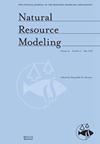多元空间过程的有效样本量及其在土壤污染中的应用
IF 2.1
4区 环境科学与生态学
Q3 ENVIRONMENTAL SCIENCES
引用次数: 4
摘要
有效样本量是指相关数据样本中包含的独立观测值的等效数量。这一概念在单变量空间变量的背景下得到了广泛的研究。在这种情况下,有效样本量决定了由于存在空间相关性而减少的样本量。在本文中,我们推广了多元空间变量的方法,以提供在同一位置测量所有变量时的共同有效样本量。与定义一起,我们提供了一些例子来研究有效样本量是什么样子的。考虑了土壤污染数据集的应用。为了降低过程的维度,采用聚类技术获得三个二元向量,这些向量使用共区域化模型建模。由于数据集的样本量适中,并且研究区域内的位置分布非常不均匀,因此空间分析具有挑战性和趣味性。我们发现,由于空间自相关的存在,样本量可以减少38.53%,避免了信息的重复。本文章由计算机程序翻译,如有差异,请以英文原文为准。
The effective sample size for multivariate spatial processes with an application to soil contamination
Effective sample size accounts for the equivalent number of independent observations contained in a sample of correlated data. This notion has been widely studied in the context of univariate spatial variables. In that case, the effective sample size determines the reduction in the sample size due to the existing spatial correlation. In this paper, we generalize the methodology for multivariate spatial variables to provide a common effective sample size when all variables have been measured at the same locations. Together with the definition, we provide examples to investigate what an effective sample size looks like. An application for a soil contamination data set is considered. To reduce the dimensions of the process, clustering techniques are applied to obtain three bivariate vectors that are modeled using coregionalization models. Because the sample size of the data set is moderate and the locations are very unevenly distributed in the study area, the spatial analysis is challenging and interesting. We find that due to the presence of spatial autocorrelation, the sample size can be reduced by 38.53%, avoiding the duplication of information.
求助全文
通过发布文献求助,成功后即可免费获取论文全文。
去求助
来源期刊

Natural Resource Modeling
环境科学-环境科学
CiteScore
3.50
自引率
6.20%
发文量
28
审稿时长
>36 weeks
期刊介绍:
Natural Resource Modeling is an international journal devoted to mathematical modeling of natural resource systems. It reflects the conceptual and methodological core that is common to model building throughout disciplines including such fields as forestry, fisheries, economics and ecology. This core draws upon the analytical and methodological apparatus of mathematics, statistics, and scientific computing.
 求助内容:
求助内容: 应助结果提醒方式:
应助结果提醒方式:


